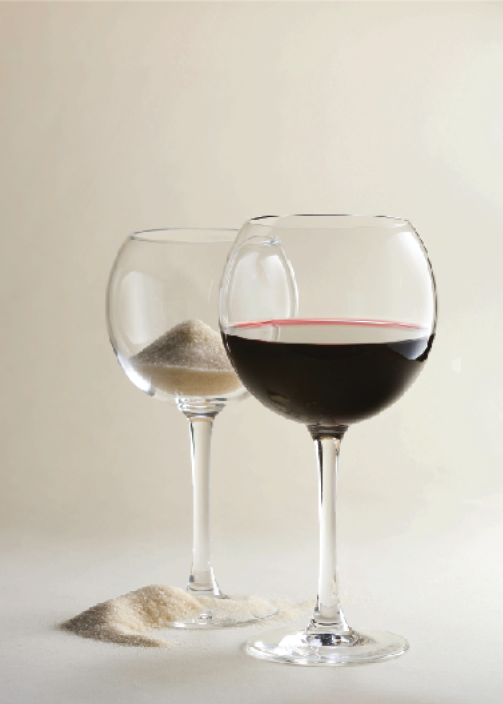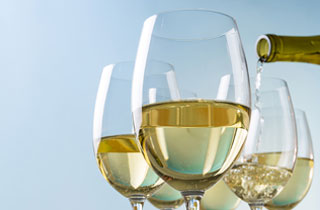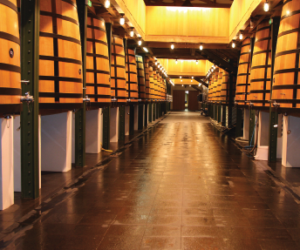 Step 1: Measuring What You Have
Step 1: Measuring What You Have
The first step in figuring out how much sugar to add is to find out how much is present in the starting material/juice. These days, most suppliers of grape juices provide the buyers with the sugar concentrations of the juices we buy — either as weight percent or (equivalently) °Brix. If you have to do your own measurements of the starting materials, you will probably do those with a hydrometer, and we know that most hydrometers have three or four scales on them — with one of them usually a Brix scale so that the equivalent percent sugar can be read directly on the hydrometer scale. I think it’s true, however, that all home winemakers’ hydrometers also contain an SG or specific gravity scale. My old hydrometer has only SG and Potential Alcohol scales, so in order to confirm or determine the sugar content of a juice or must, I have to consult some sort of conversion chart to get from SG to °Brix. As will be shown in what follows, either the SG or °Brix of the starting materials is sufficient to determine the additional sugar required.
Step 2: Knowing What You Need
My search for the real and true relationship between the sugar content of a juice and its potential alcohol (PA) level has been documented in a few previous articles on that subject (see my article, “Potential Alcohol Revisited — The Final Work” found at http://www.rochesterwinemakers.org/winemaking-information/winemaking-articles-by-members/potential-alcohol-revisited-final/). Based on that work, I show in the table in Figure 1 (below) the sugar concentrations (in °Brix) required to achieve potential alcohol levels of 10% to 14%, and then the equivalent concentrations in units of gm/L. I further list the SGs (at 20 °C) required to reach the stated potential alcohol levels.
Step 3: Getting from Where We Are to Where We Want To Be
Figuring out how much sugar to add is not a difficult problem, but many tables, charts, hydrometer scales and publications can be incorrect. The most common mistake made in calculating the amounts of sugar to add is to calculate the sugar deficiency of the must on a per-gallon basis, and then recommend that that amount of sugar be added. Although that sounds right, it’s not, and it always results in under-correction because it doesn’t take into account that the sugar addition increases the weight and volume of the wine.
Let’s look at an example to illustrate the above point. Let’s assume that we have a gallon of apple cider which our hydrometer says is 13 °Brix. If we were also to have noted the SG from our hydrometer scale, it would have been about 1.051, and that means that the gallon of cider weighs about 8.75 pounds, since water (at SG = 1.000) is 8.33 pounds/gallon. Now, since the degrees Brix of a sugar/water solution is defined as being equal to the weight% of the sugar in the solution, we know that our cider is 13% sugar. Therefore, in our gallon of cider, we have 13% x 8.75 or 1.14 pounds of sugar.
Next, let us further assume that we want to use our cider to make an apple wine with an alcohol content of 12% by volume, and that we know we need 21.1 °Brix to achieve that potential alcohol level. As we did earlier, we can calculate that we want the must to have 21.1% by weight — or 1.85 pounds of sugar per gallon. The deficiency in sugar is thus 1.85 minus 1.14 or 0.71 pounds. It is this amount (0.71 pounds) which would be recommended by many tables as the quantity of sugar to be added. However, if we look more closely at what we get when we add 0.71 pounds of sugar to our gallon of cider, we find that we have the original 1.14 pounds of sugar, plus the 0.71 pounds that we added for a total sugar weight of 1.85 pounds as desired. However, when we added the 0.71 pounds of sugar to the 8.75 pounds of cider, the total weight increased to 9.46 pounds, and the resulting °Brix of the sweetened cider is only 1.85 / 9.46 = 19.6, rather than the desired 21.1. All these calculations, by the way, can be done using the metric system knowing that one gallon is 3.79 liters and that one pound (16 ounces) is 454 grams.
The most direct route to a correct answer to the question of how much sugar to add requires the use of a little algebra; and while that isn’t difficult, it certainly makes sense to make those calculations once and save the results in some sort of tabular or graphical form for future use. I’ll present those results in a moment, but first let’s deal with the issue of sugar inversion.
If you use plain old white granulated sugar from the grocery store, you need to account for the fact that it (sucrose) gains weight as it is broken down (or inverted) into the fermentable simple sugars glucose and fructose by the enzyme invertase as a precursor to the fermentation. A molecule of water is added to each molecule of sucrose during the inversion process, and that molecule of water is incorporated into the resulting molecules of glucose and fructose, so that the total weight of sugars after the inversion is greater than the initial weight of the sucrose. In Figures 2 through 5, I have pre-compensated for the weight gain of the sucrose as a result of its inversion by reducing the amounts by 5.3%. If it is your practice to use corn sugar (aka dextrose) instead of sucrose, increase the sugar amounts shown in Figures 2 through 5 by 5.3%.
Once you have calculated the amounts of additional sugar required, it is just a matter of presenting the results in a user-friendly (and re-usable) manner. Some people prefer a tabular presentation of data while others are more comfortable with a graph. I’ve done both for the Brix case, showing the amounts of sucrose to be added to juices with Brix levels as indicated, to reach the desired potential alcohol levels. The units for the amounts of sugar to add are ounces of sucrose per gallon of juice. Interpolation can be used to determine intermediate levels.
To use the table in Figure 2, find the Brix level of the starting juice in the first column, and then move along the row until you reach the column that is headed with the desired PA value. For example, if you have a juice of 16 °Brix, and you want to make a wine with 12% ABV, enter the table at the row with the value 16 in the first column, move to the right until you reach the column with the header value of 12%, and read that 8.7 ounces of sucrose is required for each gallon of juice.
Similarly, to use the graph in Figure 3, locate the Brix level of the juice on the horizontal axis of the graph, then move vertically on the graph until you reach the line indicating the desired PA level; from that intersection move horizontally to the vertical axis where you read the amount of sucrose required. As an example here, let’s assume that we have a juice of 15 °Brix, and that we want to make a wine with 14% alcohol. To do that we go to 15 °Brix on the horizontal axis and move vertically until we reach the (brown) 14% PA line; at that point we move horizontally to the vertical axis to read our result: 16 ounces of sucrose per gallon of juice.
We can do the same thing using the SG of the juice as our measured characteristic, but I’m going to reveal my personal preference here and include only the graph (see Figure 4).
Many people (myself included) find it easier to read the necessary information from a graph rather than a table — especially if some interpolation is required. Further, the graphical presentation enables us to easily get a sense of the sensitivity of the PA of the wine to the amount of sugar we add. You can do this by noting that the lines of constant PA (i.e. 10%, 11%, etc) have vertical separations of about 2.5 oz./gal. on the vertical axis scale. This means that you need to make an error of about 2.5 oz./gal. in the amount of sugar we add to cause a 1% error in the PA of the wine.
Step 4: Revisited: An Approximation
It should be noted that anything more than a casual observation of the table in Figure 2 will reveal that the differences in the amounts in successive rows as you move up in any of the columns are all pretty close to 1.6 oz./gal. Further analysis reveals that it is a reasonably good approximation to calculate the amounts of sucrose required to reach a desired potential alcohol by:
Sucrose Required in oz./gal. ≈ 1.6 * (Target Brix – Juice Brix)
In fact, the maximum error in the above approximation is 1.3 oz/gal over the full range of the PAs and Brix levels in the Figure 2 table, and, if you restrict yourself to a PA of 12%, the maximum error due to the approximation is 0.6 oz/gal.
It my belief that the small amount of time required to formulate an overall plan for a given batch of juice — including adjustments to sugar and/or acid levels — is well-spent before any work is begun on the juice. I document each juice’s properties as the first entry into the wine-to-be’s log sheet, which is kept in the form of a Word document on my PC. As a result, I have full access to whatever reference material and spreadsheet calculations may be required, so accurate calculations are no more difficult than easy-to-use and remember approximations. A well-thought-out log sheet form could provide all the required information and allow space to enter all the appropriate data as well.
Step 5: Adding the Sugar
While you could add the required amount of sugar to the juice prior to the onset of the fermentation, it is likely that a considerable amount of stirring would be required to dissolve it. In addition, most articles on this topic suggest that the sugar required to get the must to the desired potential alcohol level should not be added before the fermentation is started to avoid overwhelming the yeast. The only yeast that I have found to be specifically mentioned as being particularly sensitive to excess initial sugar contents is Montrachet — but that is a winemaking favorite. In order to avoid potential problems, it seems advisable to add the required sugar at some point during the primary fermentation after the “native” sugar level has been reduced.
Those of us who have done it know that you should never add granulated ingredients of any kind to a fermenting must unless you have a lot of headspace in the fermenter; it causes lots of foaming! I have always added the additional sugar in the form of a syrup, which is made by adding the required amount of sugar to a small amount of water and then boiling the water to dissolve the sugar. The syrup should be cooled to somewhere near the temperature of the fermenting must before it is added, and even then the addition should be done carefully to avoid excess foaming.
Adding water to the must dilutes it, but not by a lot so long as you keep the syrup’s proportions reasonable. I use something like a 50/50 mixture by volume unless I also want to make minor adjustments to the musts’ total acidity (TA) levels via dilution. If you do add water though, you should also add some additional sugar in order to keep the potential alcohol level at the desired value. Calculating the proper amount of sugar to add in order to “fortify” the water in the syrup would seem to be a simple matter — just calculate how much sugar is required to take the added water from 0 °Brix to the required level for the chosen PA level. However, we know that the water that we will add does not contain any of the non-fermentable components for which we compensate in the potential alcohol equation. Therefore, in this case where you know you are just adding sugar and water, you can lower the target Brix levels by 3° from those shown in the table in Figure 1. When you do that and calculate the amounts of sugar required to fortify the water used to make the syrup, you get the amounts shown in the table in Figure 5. The amounts in the table are the number of ounces of sucrose required for each gallon of water to be added.
Conclusion
Well, while I said that there were three things to know, it appears that there are four steps involved in the process of adding the correct amount of sugar to take our wines to desired potential alcohol levels — with the first three steps required to figure out how much sugar to add, and the last step being the actual addition. Follow my process and you should be fine. If you use a source of information on this topic that gives values significantly different than those I have shown here, however, I suggest that you might want to check into the accuracy of the data.
Figure 1: Optimum Beginning Brix Values
Adding sugar to juices — called chaptalization — is a common practice, especially in cold climates since even grapes, which have the highest sugar content of any of the common fruits, often have insufficient sugar to produce stable wines. Wines made from other fruits, herbs or flowers always require the addition of some form of sugar in order to produce wines with sufficient alcohol concentrations to be stable. As winemakers we can follow recipes’ recommendations relative to the required amounts of sugar to add, but variations in fruit properties from year-to-year may result in unwanted variations in the wines’ alcohol contents, so it is desirable to measure what you have and adjust accordingly.
There are really three things that you need to know in order to calculate how much additional sugar is required to boost the potential alcohol level of a juice to a desired level. The first is the sugar content of the juice you are starting with. The second is — quantitatively — how the sugar concentration in the juice is converted to alcohol concentration in the wine so that we can figure out what the required sugar concentration is. And third, we need to know how to calculate the additional sugar required to get from where you are to where you want to be. The tools and techniques used to determine how much sugar to add depends somewhat on what kind of information you start with, but personal preferences play a role, too.
 Step 1: Measuring What You Have
Step 1: Measuring What You Have








